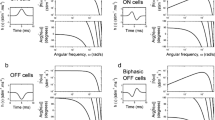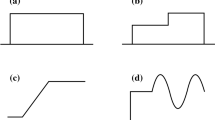Abstract
In a previous study, we used linear frequency response analysis to show that naturalistic stimulation of spider primary mechanosensory neurons produced different response dynamics than the commonly used Gaussian random noise. We isolated this difference to the production of action potentials from receptor potential and suggested that the different distribution of frequency components in the naturalistic signal increased the nonlinearity of action potential encoding. Here, we tested the relative contributions of first- and second-order processes to the action potential signal by measuring linear and quadratic coherence functions. Naturalistic stimulation shifted the linear coherence toward lower frequencies, while quadratic coherence was always higher than linear coherence and increased with naturalistic stimulation. In an initial attempt to separate the order of time-dependent and nonlinear processes, we fitted quadratic frequency response functions by two block-structured models consisting of a power-law filter and a static second-order nonlinearity in alternate cascade orders. The same cascade models were then fitted to the original time domain data by conventional numerical analysis algorithms, using a polynomial function as the static nonlinearity. Quadratic models with a linear filter followed by a static nonlinearity were favored over the reverse order, but with weak significance. Polynomial nonlinear functions indicated that rectification is a major nonlinearity. A complete quantitative description of sensory encoding in these primary mechanoreceptors remains elusive but clearly requires quadratic and higher nonlinear operations on the input signal to explain the sensitivity of dynamic behavior to different input signal patterns.







Similar content being viewed by others
References
Barth FG (2002) A spider’s world, senses and behavior. Springer, Berlin
Barth FG, Höller A (1999) Dynamics of arthropod filiform hairs. V. The response of spider trichobothria to natural stimuli. Philos Trans R Soc Lond B 354:183–192
Barth FG, Libera W (1970) Ein Atlas der Spaltsinnesorgane von Cupiennius salei Keys. Chelicerata ( Araneae). Z Morph Tiere 68:343–369
Bendat JS, Piersol AG (1980) Engineering applications of correlation and spectral analysis. Wiley, New York
Bewick GS, Banks RW (2015) Mechanotransduction in the muscle spindle. Pflügers Arch 467:175–190
Brown MC, Stein RB (1966) Quantitative studies on the slowly adapting stretch receptor of the crayfish. Kybernetik 3:175–185
Catton WT (1958) Some properties of frog skin mechanoreceptors. J Physiol 141:305–322
Chapman KM, Smith RS (1963) A linear transfer function underlying impulse frequency modulation in a cockroach mechanoreceptor. Nature 197:699–700
Cooley JW, Tukey JW (1965) An algorithm for the machine calculation of complex Fourier series. Math Comput 19:297–301
DiCaprio RA, Billimoria CP, Ludwar BCh (2007) Information rate and spike-timing precision of proprioceptive afferents. J Neurophysiol 98:1706–1717
French AS (1980a) Phototransduction in the fly compound eye exhibits temporal resonances and a pure time delay. Nature 283:200–202
French AS (1980b) Sensory transduction in an insect mechanoreceptor: linear and nonlinear properties. Biol Cybern 38:115–123
French AS, Butz EG (1973) Measuring the Wiener kernels of a non-linear system using the fast Fourier transform algorithm. Int J Control 17:529–539
French AS, Holden AV (1971) Frequency domain analysis of neurophysiological data. Comput Progr Biomed 1:219–234
French AS, Marmarelis VZ (1999) Nonlinear analysis of neuronal systems. In: Windhorst U, Johansson H (eds) Modern techniques in neuroscience research. Springer, Berlin, pp 627–640
French AS, Wong RKS (1977) Nonlinear analysis of sensory transduction in an insect mechanoreceptor. Biol Cybern 26:231–240
French AS, Holden AV, Stein RB (1972) The estimation of the frequency response function of a mechanoreceptor. Kybernetik 11:15–23
French AS, Höger U, Sekizawa S-i, Torkkeli PH (2001) Frequency response functions and information capacities of paired spider mechanoreceptor neurons. Biol Cybern 85:293–300
Gettrup E (1963) Phasic stimulation of a thoracic stretch receptor. J Exp Biol 40:323–333
Gorur-Shandilya S, Demir M, Long J, Clark DA, Emonet T (2017) Olfactory receptor neurons use gain control and complementary kinetics to encode intermittent odorant stimuli. Elife 6:e27670
Hunter IW, Korenberg MJ (1986) The identification of nonlinear biological systems: Wiener and Hammerstein cascade models. Biol Cybern 55:135–144
Jacobs GA, Miller JP, Aldworth Z (2008) Computational mechanisms of mechanosensory processing in the cricket. J Exp Biol 211:1819–1828
Juusola M, de Polavieja GG (2003) The rate of information transfer of naturalistic stimulation by graded potentials. J Gen Physiol 122:191–206
Juusola M, Weckström M, Uusitalo RO, Korenberg MJ, French AS (1995) Nonlinear models of the first synapse in the light-adapted fly retina. J Neurophysiol 74:2538–2547
Kelly M, Babineau D, Longtin A, Lewis JE (2008) Electric field interactions in pairs of electric fish: modeling and mimicking naturalistic inputs. Biol Cybern 98:479–490
Kim KI (1991) On measuring the system coherency of quadratically nonlinear systems. I EEE Trans Sig Process 39:212–214
Kim YC, Wong WF, Powers EJ, Roth JR (1979) Extension of the coherence function to quadratic models. Proc IEEE 67:428–429
Kirkpatrick S, Gelatt CD, Vecchi MP (1883) Optimization by simulated annealing. Science 220:671–680
Koles ZJ, Smith RS (1974) Characteristics of the sensory discharge of the muscle spindle in Xenopus laevis. Kybernetik 15:99–110
Kondoh Y, Okuma J, Newland PL (1995) Dynamics of neurons controlling movements of a locust hind leg: Wiener kernel analysis of the responses of proprioceptive afferents. J Neurophysiol 73:1829–1842
Korenberg MJ (1990) The identification of nonlinear biological systems: Wiener kernel approaches. Ann Biomed Eng 18:629–654
Korenberg MJ, French AS, Voo SKL (1988) White-noise analysis of nonlinear behavior in an insect sensory neuron: kernel and cascade approaches. Biol Cybern 58:313–320
Landgren S (1952) On the excitation mechanism of the carotid baroreceptors. Acta Physiol Scand 26:1–34
Levin JE, Miller JP (1996) Broadband neural encoding in the cricket cercal sensory system enhanced by stochastic resonance. Nature 380:165–168
Lewen GD, Bialek W, de Ruyter van Steveninck R (2001) Neural coding of naturalistic motion stimuli. Network 12:317–329
Marquardt D (1963) An algorithm for least-squares estimation of nonlinear parameters. SIAM J Appl Math 11:431–441
Matthews PBC, Stein RB (1969) The sensitivity of muscle spindle afferents to small sinusoidal changes in length. J Physiol 200:723–743
Miller JP, Jacobs GA, Theunissen FE (1991) Representation of sensory information in the cricket cercal sensory system. I. Response properties of the primary interneurons. J Neurophysiol 66:1680–1689
Molina J, Schaber CF, Barth FG (2009) In search of differences between the two types of sensory cells innervating spider slit sensilla (Cupiennius salei Keys). J Comp Physiol A 195:1031–1041
Moss F, Pierson D, O’gorman D (1994) Stochastic resonance: tutorial and update. Int J Bifurc Chaos 4:1383–1397
Pfeiffer K, French AS (2015) Naturalistic stimulation changes the dynamic response of action potential encoding in a mechanoreceptor. Front Physiol 6:303
Poppele RE (1981) An analysis of muscle spindle behaviour using randomly applied stretches. Neuroscience 6:1157–1165
Press WH, Flannery BP, Teukolsky SA, Vetterling WT (1990) Numerical recipes in C. The art of scientific computing. Cambridge University Press, Cambridge
Pringle JW, Wilson VJ (1952) The response of a sense organ to a harmonic stimulus. J Exp Biol 29:220–234
Rieke F, Bodnar DA, Bialek W (1995) Naturalistic stimuli increase the rate and efficiency of information transmission by primary auditory afferents. Proc R Soc Lond B 262:259–265
Rien D, Kern R, Kurtz R (2013) Octopaminergic modulation of a fly visual motion-sensitive neuron during stimulation with naturalistic optic flow. Front Behav Neurosci 7:155
Shannon CE, Weaver W (1949) The mathematical theory of communication. University of Illinois Press, Urbana
Spekreijse H, Oosting H (1970) Linearizing: a method for analysing and synthesizing nonlinear systems. Kybernetik 7:22–31
Stein RB, French AS, Holden AV (1972) The frequency response, coherence and information capacity of two neural models. Biophys J 12:295–322
Tolhurst DJ, Tadmor Y, Chao T (1992) Amplitude spectra of natural images. Ophthalmic Physiol Opt 12:229–232
Torkkeli PH, French AS (2002) Simulation of different firing patterns in paired spider mechanoreceptor neurons: the role of Na\(^{+}\) channel inactivation. J Neurophysiol 87:1363–1368
Torkkeli PH, Meisner S, Pfeiffer K, French AS (2012) GABA and glutamate receptors have different effects on excitability and are differentially regulated by calcium in spider mechanosensory neurons. Eur J Neurosci 36:3602–3614
van Hateren JH (1997) Processing of natural time series of intensities by the visual system of the blowfly. Vis Res 37:3407–3416
van der Schaaf A, van Hateren JH (1996) Modelling the power spectra of natural images: statistics and information. Vis Res 36:2759–2770
Acknowledgements
This study was supported by the Canadian Institutes for Health Research and the Natural Sciences and Engineering Council of Canada.
Author information
Authors and Affiliations
Corresponding author
Additional information
Communicated by Jan Benda.
Rights and permissions
About this article
Cite this article
French, A.S., Pfeiffer, K. Nonlinearization: naturalistic stimulation and nonlinear dynamic behavior in a spider mechanoreceptor. Biol Cybern 112, 403–413 (2018). https://doi.org/10.1007/s00422-018-0763-0
Received:
Accepted:
Published:
Issue Date:
DOI: https://doi.org/10.1007/s00422-018-0763-0




